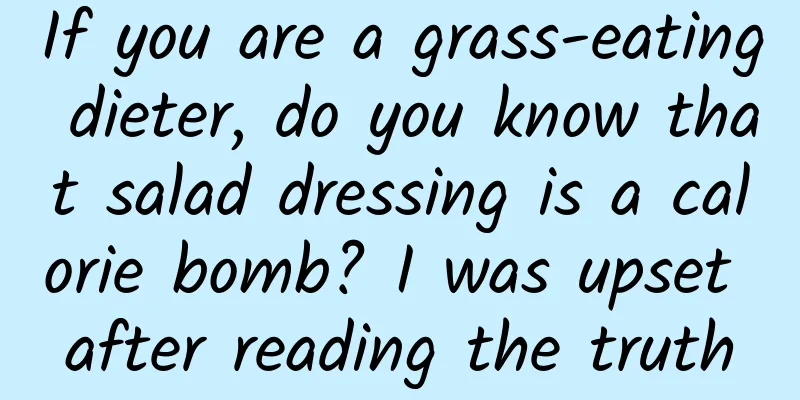If you are a grass-eating dieter, do you know that salad dressing is a calorie bomb? I was upset after reading the truth

|
Summer is coming, it's time to lose weight! Replace noodles, rice noodles, rice bowls, and skewers with vegetable salads. Work hard for three months, and enjoy the summer! After eating salad for half a month, you check on the scale and ask yourself: Why am I fatter?! Why did you suffer from eating grass for half a month?! Why? Because I added too much salad dressing! Special mention This article does not deny the nutritional value of salad, it simply discusses the issue of salad dressing. Every salad dressing has a different recipe, and we're talking about the commonalities of most products. If you want a low-calorie solution, you can scroll directly to the end of the article. Sauce, oil There is a saying that the origin of Western sauces is because Westerners thought spices were too expensive, so they mixed a little bit of precious spice crops with a large amount of oil or dairy products and flour to make sauces with spice flavor. So salad dressing is just an oil barrel, and the calories are higher than you expected. Don't think that eating it with salad will turn it into a diet food. Next, let’s take a look at common salad dressings and what they are essentially. Calorie ranking of common salad dressings Mayonnaise > Thousand Island dressing > Tahini > Caesar dressing > Ketchup > Vinaigrette Mayonnaise: The ultimate calorie bomb "Mayonnaise is good. It has eggs. My parents will be very happy to know that I eat this." Let me tell you the truth: there is much more oil in mayonnaise than egg yolk. The ingredients list on food packaging has a particular order in which the ingredients are listed. The first few are listed in descending order of added amount. The first three ingredients in most mayonnaise are as follows: vegetable oil, egg yolk, and water. The ingredient list of a popular mayonnaise in the market丨Taobao screenshot Because the most important ingredient in mayonnaise is oil, it is really high in calories. Every 100 grams has about 3,000 kilojoules of calories, which meets 35% of the daily calorie requirement. Wow, this is really good! In terms of calorie density, I recommend mayonnaise to apply for individual rations. Eat a spoonful in the morning and you will be energetic until noon. A type of mayonnaise containing 76.5% fat丨Taobao screenshot Portable small packages of mayonnaise usually contain 25 to 30 grams, which we believe is the amount needed for a salad. Even if the vegetables, grains, roots, and meat in the salad are all counted as 0 calories, this salad still has nearly 750 kilojoules. Do you know how many calories are in two taels of beef? 1046 kilojoules. Why should we suffer the punishment of eating salad on this spring day when food is abundant instead of eating other delicious foods? The small bag in the picture is 25 ml, and the bottle is 200 ml丨Taobao screenshot Let’s take a look at the production process of mayonnaise to get a visual feel for how much oil is in it. The brownish-yellow substance at the bottom of the large glass container is a mixture of an egg yolk, a small amount of salt, vinegar, and yellow mustard sauce. The large cup in my hand is full of oil, which needs to be added completely. Image: youtube@Downshiftology The final sauce is this much. There is only one egg yolk in it, and the volume is all supported by oil. Image: youtube@Downshiftology Just a quick question: How many tablespoons of mayonnaise did you add to your salad last time? Thousand Island Dressing: A Derivative of Mayonnaise Thousand Island dressing, the most commonly used dressing for vegetable salads, is actually not as light as its name suggests. It is made with mayonnaise as the base, and its fat content is still high, but its calories are slightly lower than the latter. Vegetable salad with Thousand Island dressing | wikimedia commons/Oliver DelaCruz The general Thousand Island sauce still has more oil than water丨Taobao screenshot Let's look at the nutritional information table. Taking this Thousand Island dressing as an example, every 100 grams of dressing contains more than 40 grams of fat and a total calorie content of about 2,000 kilojoules, which is 23% of a person's daily requirement. Roasted sesame paste: also "oil + water" The sesame sauce mentioned here is the one used for salads, not the one used by Beijingers for hot pot. The first three ingredients are vegetable oil, water, and soy sauce, which shows that the fat content of this delicious sauce is not low; the calories per 100 ml are nearly 1,700 kilojoules, which is lower than Thousand Island dressing. A roasted sesame salad dressing with a high market penetration rate contains 40 grams of fat per 100 ml丨Taobao screenshot By the way, sesame paste for hot pot, peanut butter for bread, etc., because the raw materials are all oil crops, the calories of the sauce will not be low. Every 100 grams of sesame paste actually contains 50 grams to 60 grams of fat. Caesar dressing: slightly lower in calories, more water than oil Caesar dressing is the standard dressing for Caesar salad. The base is similar to mayonnaise, with garlic, lemon, mustard, cheese, etc. We looked at several popular Caesar dressings and found that water came before oil in the ingredient list, which means that Caesar dressings tend to have more water than oil and therefore have slightly fewer calories. In the ingredient lists of several Caesar dressings, water is listed before oil. 丨 Screenshot from Taobao The calories of Caesar dressings with different recipes vary greatly: the highest is 1528 kJ/100g, while the lowest is only 892 kJ/100g, which is 58% of the former. When buying Caesar dressing, try to choose the low-calorie one. In the ingredient lists of several Caesar dressings, water is listed before oil. 丨 Screenshot from Taobao Ketchup: tomatoes + sugar, no fat Maybe someone likes to mix salad with ketchup, so we can talk about that too. The classic ketchup from the world's largest ketchup company has water, concentrated tomato puree, and fructose syrup as the first few ingredients in its ingredient list. The calorie content is about 500 kilojoules per 100 grams, accounting for 6% of the daily energy requirement, which is much lower than the oil-and-water salad dressings mentioned above. The essence of ketchup is tomatoes and sugar, not oil. The calories of common sweet condiments such as sucrose, fructose syrup, and corn syrup are only about one-third of the same weight of vegetable oil. Of course, eating a lot of ketchup is still not a good idea for people who want to lose weight... The ingredients list of this tomato sauce丨Taobao screenshot Nutritional information of this tomato sauce丨Taobao screenshot Vinaigrette: It’s called vinaigrette, but it doesn’t have a lot of oil Vinaigrette is the only one of these sauces that has "oil" written on it. However, it is not that oily. Traditional vinaigrette is made with three parts oil and one part vinegar. But after some research, I found that the vinaigrettes with the highest sales on shopping platforms have a very low proportion of oil, and the order of ingredients is mostly water, soy sauce, sugar, vegetable oil, vinegar (some even contain no oil at all). This way, the calories are very low, and one or two vinaigrettes are only about 200 kilojoules, which is like eating half an apple. Two popular brands of vinaigrettes are both low in calories and don't even use oil. 丨Taobao screenshot The trick of 0 sugar sauce and 0 fat sauce While browsing the shopping website, I saw a lot of 0-sugar sauces and 0-fat sauces. But many of these 0-sugar and 0-fat sauces are just deceptions! 0Sugar Trap First of all, 0 sugar does not mean 0 fat. Sugar-free is high in fat and calories. In addition, some sauces say they are free of sucrose, but they don’t say they are free of fructose syrup, glucose syrup, maltose, honey, and crystallized fructose… These things are also sugars and make people fat. Do you remember the sucrose-free Yuanqi Forest Milk Tea? 0 fat trap Same as mentioned above: fat-free, but can contain sugar! However, the calories in fat are much higher than those in sugar, so the calories in zero-fat sauce are still significantly lower than regular ones, so you won’t go wrong by choosing it. Label Trap There is also a trap on the label, which I will discuss here. Look at the mayonnaise below, it has a very low calorie content of 414 kilojoules. But! The label does not say that there are 414 kilojoules of calories per 100 grams of mayonnaise, but 414 kilojoules of calories per 15 grams. In other words, the calories of this mayonnaise are 2760 kilojoules per 100 grams. The nutritional information is calculated based on "per 15 grams" instead of "per 100 grams"丨Taobao screenshot Therefore, if you are determined to lose weight, you must read the units of the nutritional information carefully, combine it with the ingredient list, and then decide whether to buy this sauce. What kind of sauce should I use? We can also open up the concept and consider Chinese seasonings. Soy sauce, oyster sauce, vinegar, pickled chili peppers, basically have no calories. I still remember that many years ago, a friend from Shanxi Province gave up all high-calorie condiments in order to lose weight, leaving only vinegar, "everything can be eaten with vinegar." I just discovered that although it is called oyster sauce, it does not contain fat丨Li Xiaokui The dry sauce you make at home using chili powder, pepper powder and a little salt is delicious and has no calories at all. There are also packaged dry sauces on the market, but compared to the homemade recipes mentioned above, they often contain vegetable oil and are not as calorie-free as they seem. If you have a strong taste and like spicy food, and can eat several packets of sauce at a time, it is better to be cautious with it. A very popular dry sauce dip in Sichuan, rapeseed oil is the second ingredient. This type of dry sauce dip has about the same calories as ketchup. 丨Li Xiaokui There are also many low-calorie Western sauces, such as yellow mustard sauce, mustard cucumber hamburger sauce, etc. You can go to the sauce area of the supermarket and look at the ingredient list and nutritional information on the bottle, which is quite interesting! Summary of key points: 1. Salad dressings are often high in calories, so don't add too much when eating salad; if you have strict calorie control needs, such as if you are losing weight, then don't touch them at all. 2. Salad dressings with lower calories include ketchup, vinaigrette, and other sauces with zero fat recipes. 3. Try to mix salad with low-calorie Chinese seasonings such as soy sauce, vinegar, oyster sauce, pickled peppers, etc. Don't eat too much, because eating too much salt will also cause edema and make you look fat! Author: Li Xiaokui Editor: luna An AI If you eat salad to supplement your vegetables, then I support you frying it with lard. This article comes from Guokr and may not be reproduced without permission. If necessary, please contact [email protected] |
<<: Can cats also get Down syndrome?
>>: The little assistant who served Bethune back then is now 101 years old!
Recommend
Methodology for creating hot-selling traffic products!
Recently, I managed a growth plan for a star comp...
Zscaler: iOS apps leak more user data than Android apps
By analyzing the transaction status of devices pr...
Laser technology changes advertising: large naked-eye 3D screen
Recently, Austrian researchers announced that the...
Content consumption apps: QQ Reading, Get, Himalaya FM, which one is better?
Imagine that you get up in the morning and sit on...
iOS componentization exploration: creation of private libraries
iOS componentization is basically based on cocoap...
The national high-value tough guy Roewe RX8 will be equipped with a non-load-bearing body
Most of the SUVs on the streets nowadays are urba...
Are the popular Wu Tiao Ren actually marketing experts?
There is a theory of a hit product creation model...
Why is Visual Studio Code so popular all of a sudden? Let’s take a deep look at it!
This article was translated from Techcrunch by @O...
Why are all the ads I see on TikTok games?
Capture SSS-level Lingkun at the beginning, 5th t...
Zhihu Money Making Camp: Earn over 100,000 RMB a month in 2 months with no basic knowledge
Zhihu sideline earning project practical camp, 0 ...
The market value of JJ Lin's Metaverse real estate plummeted? Can digital assets be trusted? | Digital Literacy
Audit expert: Zhu Guangsi Member of Beijing Scien...
The latest Douyin film and television account transfer technology in 2021, a film and television work every 3 to 5 minutes, you can make money with just a mobile phone
If you ask what is the hottest and most profitabl...
Learn something new! "Band-Aid" is not "Band-Aid"!!!
Recently, a topic on Weibo titled "Band-Aids...
Why do people rub their hands first when a fly lands on food? I was shocked after reading the truth
When we mention flies, we always think of decay, ...
Exclusive reveal of the prequel to WeChat red envelopes
[[128084]] The WeChat red envelope system code wr...









